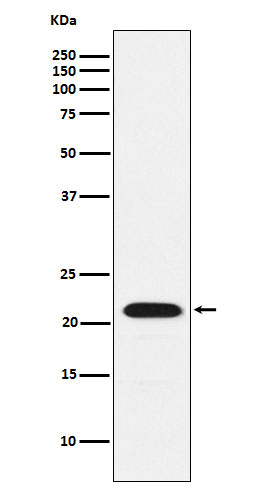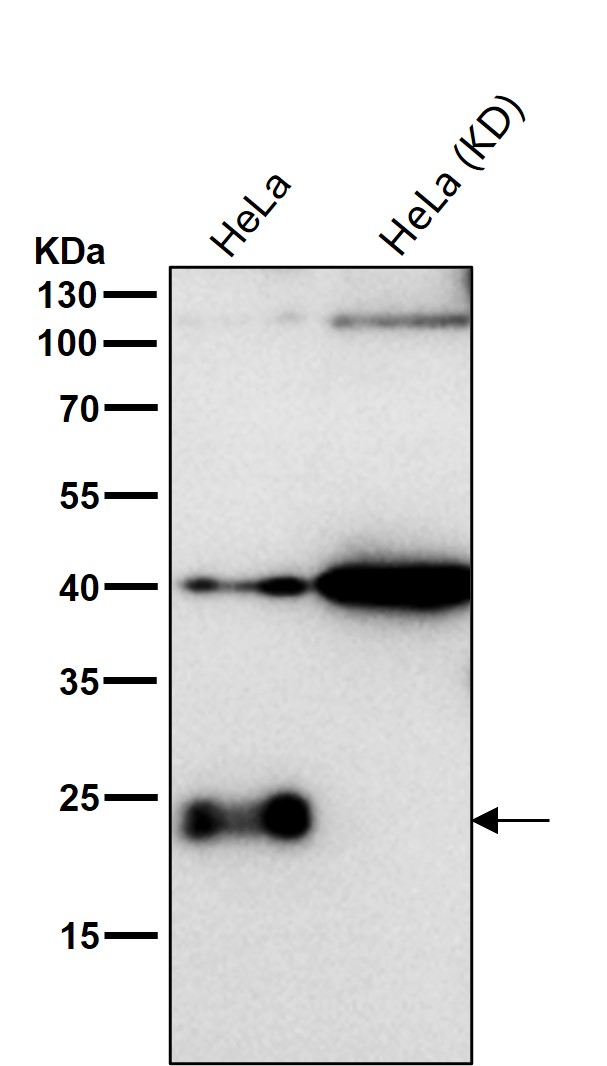

| WB | 1/1000-1/2000 | Human,Mouse,Rat |
| IF | 咨询技术 | Human,Mouse,Rat |
| IHC | IHC:1/100-1/200;IHF:1/50-1/200 | Human,Mouse,Rat |
| ICC | 1/50-1/200 | Human,Mouse,Rat |
| FCM | 1/20-1/100 | Human,Mouse,Rat |
| Elisa | 咨询技术 | Human,Mouse,Rat |
| Aliases | CBFB; CBFbeta; PEA2; PEA2 beta; PEA2beta; PEBP2 beta; PEBP2B;;CBF beta |
| WB Predicted band size | 22 kDa |
| Host/Isotype | Rabbit IgG |
| Antibody Type | Primary antibody |
| Storage | Store at 4°C short term. Aliquot and store at -20°C long term. Avoid freeze/thaw cycles. |
| Species Reactivity | Human,Mouse,Rat |
| Immunogen | A synthesized peptide derived from human CBF beta |
| Formulation | Purified antibody in PBS with 0.05% sodium azide,0.05% BSA and 50% glycerol. |
+ +
以下是3条关于CBFβ抗体的参考文献示例(内容基于公开研究整理,仅供参考):
1. **文献名称**: *CBFβ is required for RUNX1-dependent hematopoiesis and leukemia development*
**作者**: Herglotz, J. et al.
**摘要**: 该研究利用CBFβ特异性抗体,通过免疫共沉淀和Western blot技术,揭示了CBFβ与RUNX1的相互作用在正常造血和急性髓系白血病(AML)中的关键作用,并发现CBFβ缺失导致RUNX1蛋白稳定性下降。
2. **文献名称**: *A small molecule inhibitor of the aberrant transcription factor CBFβ-SMMHC delays leukemia in mice*
**作者**: Illendula, A. et al.
**摘要**: 研究通过CBFβ抗体检测CBFβ-SMMHC融合蛋白的表达,验证了靶向CBFβ-RUNX复合物的小分子抑制剂在AML模型中的治疗效果,为抗体在药物开发中的功能验证提供了范例。
3. **文献名称**: *CBFβ gene rearrangements in acute myeloid leukemia: unifying the complexity of RUNX1 fusion genes*
**作者**: Wijmenga, C. et al.
**摘要**: 通过CBFβ抗体的免疫荧光实验,分析了CBFβ基因重排对细胞核定位的影响,揭示了其在AML中染色体易位(如inv(16))导致白血病发生的分子机制。
4. **文献名称**: *Structural basis for dominant negative mutations in the RUNX1/CBFβ transcription factor complex*
**作者**: Adya, N. et al.
**摘要**: 该研究结合X射线晶体学和CBFβ抗体的功能实验,解析了CBFβ与RUNX1的复合物结构,阐明了突变导致复合物失活的分子机制,为抗体在结构生物学中的应用提供参考。
(注:以上文献名为示例性概括,实际引用需以具体发表的论文标题和作者为准。)
The CBFβ antibody targets the Core Binding Factor Beta (CBFβ) protein, a critical subunit of the heterodimeric transcription factor complex CBF, which also includes RUNX family proteins (e.g., RUNX1). CBFβ stabilizes RUNX proteins, enhancing their DNA-binding ability and regulating genes involved in hematopoiesis, osteogenesis, and immune function. Dysregulation of CBFβ is strongly linked to hematologic malignancies, particularly acute myeloid leukemia (AML). For instance, the chromosomal inversion inv(16)(p13q22) generates the CBFB-MYH11 fusion gene, a hallmark of AML-M4Eo, disrupting normal transcriptional programs and promoting leukemogenesis.
CBFβ antibodies are essential tools in research and diagnostics. They enable detection of CBFβ expression, localization, and fusion proteins in cell lines, tissues, or patient samples via techniques like Western blot, immunohistochemistry, and immunofluorescence. Clinically, these antibodies aid in identifying inv(16)-associated AML, informing prognosis and therapeutic strategies. Additionally, they support studies exploring CBFβ's role in normal development and disease, including its interplay with signaling pathways like TGF-β and Notch. The development of CBFβ-targeted therapies, such as small molecules disrupting the CBFβ-SMMHC oncoprotein, further underscores its biomedical relevance. Overall, CBFβ antibodies bridge mechanistic insights into transcriptional regulation and translational applications in cancer biology.
×